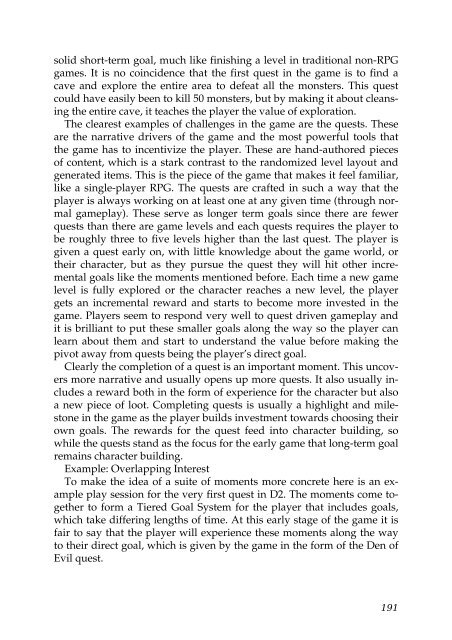Well Played 2.0: Video Games, Value and Meaning - OpenLibra
Well Played 2.0: Video Games, Value and Meaning - OpenLibra
Well Played 2.0: Video Games, Value and Meaning - OpenLibra
You also want an ePaper? Increase the reach of your titles
YUMPU automatically turns print PDFs into web optimized ePapers that Google loves.
solid short-term goal, much like finishing a level in traditional non-RPG<br />
games. It is no coincidence that the first quest in the game is to find a<br />
cave <strong>and</strong> explore the entire area to defeat all the monsters. This quest<br />
could have easily been to kill 50 monsters, but by making it about cleansing<br />
the entire cave, it teaches the player the value of exploration.<br />
The clearest examples of challenges in the game are the quests. These<br />
are the narrative drivers of the game <strong>and</strong> the most powerful tools that<br />
the game has to incentivize the player. These are h<strong>and</strong>-authored pieces<br />
of content, which is a stark contrast to the r<strong>and</strong>omized level layout <strong>and</strong><br />
generated items. This is the piece of the game that makes it feel familiar,<br />
like a single-player RPG. The quests are crafted in such a way that the<br />
player is always working on at least one at any given time (through normal<br />
gameplay). These serve as longer term goals since there are fewer<br />
quests than there are game levels <strong>and</strong> each quests requires the player to<br />
be roughly three to five levels higher than the last quest. The player is<br />
given a quest early on, with little knowledge about the game world, or<br />
their character, but as they pursue the quest they will hit other incremental<br />
goals like the moments mentioned before. Each time a new game<br />
level is fully explored or the character reaches a new level, the player<br />
gets an incremental reward <strong>and</strong> starts to become more invested in the<br />
game. Players seem to respond very well to quest driven gameplay <strong>and</strong><br />
it is brilliant to put these smaller goals along the way so the player can<br />
learn about them <strong>and</strong> start to underst<strong>and</strong> the value before making the<br />
pivot away from quests being the player’s direct goal.<br />
Clearly the completion of a quest is an important moment. This uncovers<br />
more narrative <strong>and</strong> usually opens up more quests. It also usually includes<br />
a reward both in the form of experience for the character but also<br />
a new piece of loot. Completing quests is usually a highlight <strong>and</strong> milestone<br />
in the game as the player builds investment towards choosing their<br />
own goals. The rewards for the quest feed into character building, so<br />
while the quests st<strong>and</strong> as the focus for the early game that long-term goal<br />
remains character building.<br />
Example: Overlapping Interest<br />
To make the idea of a suite of moments more concrete here is an example<br />
play session for the very first quest in D2. The moments come together<br />
to form a Tiered Goal System for the player that includes goals,<br />
which take differing lengths of time. At this early stage of the game it is<br />
fair to say that the player will experience these moments along the way<br />
to their direct goal, which is given by the game in the form of the Den of<br />
Evil quest.<br />
191

















